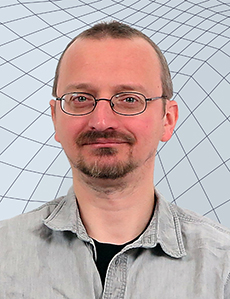
Research Scientist
Numerics Cluster
Physical and Computational Acoustics
Tel. +43 1 51581-2518
Email: wolfgang.kreuzer@oeaw.ac.at
Scientific IDs:
ORCID: 0000-0003-3772-0514
Academic Background
Wolfgang Kreuzer studied Technical Mathematics at the Technical University of Vienna. After finishing his Ph.D at the Technical University of Vienna (Diploma 1996: Modelling the Cortical Organ with finite Elements, PhD Thesis: Computer aided analysis of the iterative defect correction with respect to stiff differential equations), he worked at the Institute for Applied and Numerical Mathematics at the TU-Vienna.
From 2004 to 2005, he worked as project employee at a joint project of the Institute for Distributed and Multimedia Systems at the University of Vienna and the Institute for Theoretical Chemistry. Since 2004, he has works at the Acoustics Research Institute of the Austrian Academy of Sciences, where he joined the Physical and Compuational Acoustics group
Current Research
The main focus of his current work lies in applied and numerical mathematics, in particular
- Boundary Element Methods for the Helmholtz Equation
- Development of Numerical Algorithms
- Numerical Simulation of HRTFs
- Propagation of Noise and Vibrations
- Frames in Acoustics: BIOTOP
Projects
Publications
Publications
- Kreuzer W.; Pollack K.; Brinkmann F.; Majdak P. (2024) NumCalc: An open-source BEM code for solving acoustic scattering problems. Engineering Analysis with Boundary Elements, Bd. 161, S. 157-178.
- Waubke H.; Soni P.; Kasess C.; Kreuzer W. (2023) 2.5D Boundary element method for the detection of moving sources. Proceedings of the Forum Acusticum 2023. Turin.
- Brinkmann F.; Kreuzer W.; Thomsen J.; Dombrovskis S.; Pollack K.; Weinzierl S.; et al. (2023) Recent Advances in an Open Software for Numerical HRTF Calculation. J. Audio Eng. Soc, Bd. 71, S. 504-514.
- Kasess C.H.; Kreuzer W.; Waubke H. (2023) Effiziente Rücktransformation bei 2.5D BEM für bewegte Quellen. Fortschritte der Akustik - DAGA 2023. Hamburg S. 353 - 356.
- Kreuzer W. (2023) Adaptive Kollokations BEM. Fortschritte der Akustik - DAGA 2023. Hamburg S. 1043-1045.
- Kreuzer W.; Pollack K.; Majdak P.; Brinkmann F. (2022) Mesh2HRTF / NumCalc: An Open-Source Project to CalculateHRTFs and wave scattering in 3D. Proceedings of the Euroregio/BNAM 2022. Aalborg, Denmark S. 443-452.
- Pollack K.; Kreuzer W.; Majdak P. (2022) Modern Acquisition of Personalised Head - Related Transfer Functions: An Overview. In: Advances in Fundamental and Applied Research on Spatial Audio.. IntechOpen, London S. 25-61.
- Kreuzer W. (2022) Numerical simulation of sound propagation in and around ducts using thin boundary elements. Journal of Sound and Vibration, Bd. 534, S. 117050.
- Kasess C. H.; Maly T.; Kreuzer W. (2022) Modeling of multiple reflections between noise barriers and trains using the boundary element method. Proceedings of the Euregio/BNAM 2022. Aalborg, Denmark. S. 423-432.
- Kreuzer W.; Brinkmann F.; Pollack K.; Majdak P. (2022) MeMesh2HRTF/NumCalc: Ein quelloffenes Paket zur Berechnung von HRTFs und akustischer Wellenausbreitung in 3D. Fortschritte der Akustik - DAGA 2022. Stuttgart.
- Balazs P.; Kasess C.; Kreuzer W.; Maly T.; Průša Z.; Jaillet F. (2021) Anwendung von Rahmen-Multiplikatoren für die Extraktion von Kurvenquietschen von Zugsaufnahmen. e & i Elektrotechnik und Informationstechnik, Bd. 138, S. 206-211.
- Kasess C. H.; Maly T.; Balazs P.; Kreuzer W. (2021) Time-variant signal manipulation using frame multipliers. Euronoise, Madeira. Madeira S. 673-682.
- Waubke H.; Kreuzer W.; Schmutzhard S.; Hrycak T. (2020) Finite elements in Fourier transformed domain for the simulation of trains in tunnels. Proceedings of Forum Acusticum 2020, Lyon. Lyon S. 3309-3311.
- Kreuzer W. (2019) Using B-spline frames to represent solutions of acoustics scattering problems. Journal of Computational and Applied Mathematics, Bd. 351, S. 331-343.
- Majdak P.; Kreuzer W.; Baumgartner R.; Mihocic M.; Reichinger A. (2019) Method for determining listener-specific head-related transfer functions. .
- Kreuzer W. (2019) Using B-spline frames to represent solutions of acoustics scattering problems. 14th International Conference on Mathematical and Numerical Aspects of Wave Propagation. Book of Abstracts. (M. Kaltenbacher, Melenk, J. M., and Nannen, L., eds.).
- Kreuzer W.; Weber V. (2019) BEM-simulation of tubes using thin elements. Proceedings in Applied Mathematics & Mechanics. Wiley, .
- Kreuzer W.; Weber V. (2019) BEM Simulation of tube acoustics using thin elements. Proceedings of the 23rd International Congress on Acoustics. Aachen.
- Brand J.; Kreuzer W.; Gräf M.; Ehler M. (2017) Vergleich verschiedener Abtastmethoden auf der Kugeloberfläche. Fortschritte in der Akustik DAGA. Kiel S. 1291-1294.
- Kreuzer W.; Brand J. (2017) B-Splines und Frames. Fortschritte in der Akustik (DAGA 2017). Kiel S. 711-714.